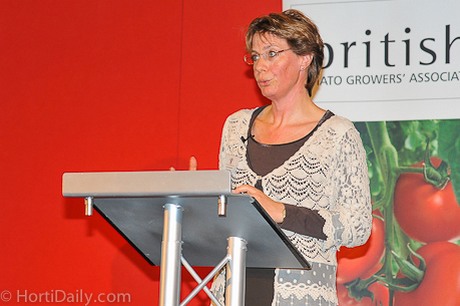The practice of grafting the scion of one plant to the rootstock of another started out as desire to combat disease and get plants that could thrive in lower temperatures. The practice has developed to address a host of other issues facing growers, though the means and the goal remain the same: graft together plants with desirable traits to end up with a better-performing plant. Hoogendonk noted that this can be seen today with present-day tomato growers who use grafting to get better quality produce.

“In Holland, there's growers who have always been looking towards a solution that eliminates the infection rate of the PepinoMozaik virus among tomatoes,” said Hoogendonk. “So grafting the right varieties onto a good rootstock that's resistant to that has become a common solution.” She added that the benefits to tomato-growers in Northern Europe are so great that 95 percent of them engage in the practice nowadays. In Southern Europe, where there's more variation between seasons and where cold-resistance isn't as vital, only 45 percent of growers engage in the practice, though Hoogendonk added that an increasing number of growers there are turning to grafting.

“Grafting is an art,” noted Hoogendonk. “By matching the right plant to the right rootstock you can get better food quality, firmer fruit, less micro-cracking and higher yields.” Results have traditionally been based on the quality of the graft, nowadays mostly done manually by female hands, though the establishing of best practices and the future promise of help through automation could improve the success rate of grafts. But what can't be automated is the choice of rootstock, and that's something Hoogendonk stressed the importance of.
“The best rootstock for a crop depends on several things,” explained Hoogendonk. Se was giving the growers manners as an example. Do you want to grow a vegetative or a more generative plant? Do you grow on a vegetative of a generative substrate? Pick the right rootstock and you can have better control of this, or pick a rootstock that is in between both worlds. Of course the location where you are growing does also matter as the amount of light in your glasshouse will determine how much energy the plant receives, so the rootstock will have a reaction to the environment. Also use of CO2 in the greenhouse is a factor to keep in mind; these levels are also important, and though it will mostly affect the scion, it will have an indirect effect on the rootstock."

Hoogendonk added that tomato grafting is not an easy thing and also demands a lot of experience at the propagation nursery; "When you want to graft, you need to plant first of all. The size of the scion and the rootstock plant must be taken into consideration; they must be propagated at the same size at the same time. The chosen rootstock must be large and strong enough to handle the scion grafted onto it. The key to a successful graft is finding the parts that will result in the balance necessary to survive in the growing environment. In that respect, Hoogendonk signalled a need to focus more on rootstock, she presented several rootstocks by De Ruiter Seeds, and showed what kind of characteristics each rootstock has to offer.
“The rootstock makes a big difference, and we have long conversations about what scion to use, but we don't talk enough about the rootstock,” said Hoogendonk. “But this is a very important part of the crop, and it's something that really deserves more attention.”
Click here to launch Rootmap: a handy tool by De Ruiter Seeds in order to select a rootstock that suits you.

